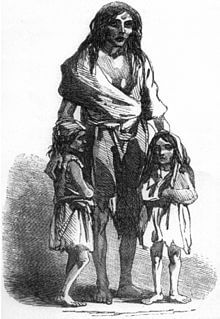Why are we all wearing green today? How is it that one particular ethnic group came to figure so fully—politically, culturally—in the American story, to the point that as a society we endorse the notion that “today, everyone is Irish”? It is an odd historical circumstance: papists finding not only freedom, but generating incredible prosperity in the WASPish land of the United States. The story of Irish-Americans endures as one of tragedy and rebirth, preserved in the songs of a peculiar culture at a momentous time in world history. But why speak of “Irish-Americans” at all?
“For God’s sake take us out of poverty, and don’t let us die with the hunger.”
Irish-American history is often told from the standpoint of the potato famine. This is as problematic as it is sensical. Irish emigration took place in great numbers in the years preceding the great famine (1845-1850). But there is no doubt that the majority of Irish emigration took place after 1850.
Regardless of their era, individuals were often aided by family and friends already settled in a foreign land. Not only bound for the United States, but for Canada, Australia and New Zealand, Irish emigrants went on a journey away from their homeland in search of a new life. Anything was better than what Ireland had been transformed into over the previous three hundred years. The famine—deliberately abetted by British policy—was the culmination of hundreds of years of history, recognizable to anyone who lived through the events.
To be totally honest with you, I’m not sure exactly when British and Irish animosity became a fact of geopolitics. Certainly, Henry VIII’s government made moves to subjugate Ireland. The details of these ongoing affairs can generally be reduced to this interaction: The British monarch/government would express control of landownership in Ireland, and these statements would be contested by Irish kings. Consistently, the Irish would rebel, but British authority would remain firmly in place and often propped up by victory. Below is my attempt to make sense of the story. And so we begin, during a rebellion…
Landlord Policy (c.1550-1850)

By 1600, Hugh O’Neill had established a confederacy and successfully fomented rebellion against British authority in Ireland. Not the first, nor the last large scale Irish rebellion, O’Neill’s attempt illuminates Irish attitudes toward the crown and “Irish-ness” in general. Thoroughly papist, with a tinge of nationalism rooted in the concept of Irish landownership—or rather, by tying Irish identity to the land of Ireland itself—, O’Neill sought to organize and unify Irish kings in the name of an independent, Catholic Ireland.*
He lost. Like so many Irish rebels into the seventeenth century, O’Neill could not successfully unify Irish sympathy to defeat the English army (a tall task, especially for an island 200 km away from the early-modern superpower). Unsuccessful rebellions led to greater English control, who exercised power through landlord domination—single estates towered over the Irish countryside, wresting over control of the land from those who had tilled it for generations.
Irish farmers were reduced to tenants of what were essentially shantytowns. Already a poor, rural, intensely local society, Ireland crumbled under the weight of empire. The history of Irish-English wars in the late sixteenth and seventeenth centuries bring to light the causes of the next great crisis that would drive a wedge between Ireland and England.
Post-War Napoleonic Depression
Irish Catholics had been “rooting” for Napoleon—Emperor of Catholic France—while he campaigned his way across Europe. His final defeat in 1815 put an end to any hope of British weakening—their main enemy vanquished, the polity rose into a new era of prosperity. Industrial output of textiles and other would-be homespun goods flooded the Irish market, driving down prices and upsetting the status quo.
Grain prices fell, and potatoes became the only viable crop. Irish cattle were shipped to England. Throughout all of this, Irish population rose considerably (“from 5 million in 1800 to 8.5 million in 1845”**). A perfect storm was brewing. Forced into monoculture, the Irish people had nothing to subsist on when plague struck their potato plants, rendering the only available food stuff inedible.
British response was horrific. Taxes took food that could have alleviated the famine, and those who could not pay were evicted from their meager holdings. For it was “not the physical evil of the famine, but the moral evil of the selfish, perverse, and turbulent character of the Irish people” that was at the heart of the problem for the “Director of British government direct relief efforts”, Lord Charles Trevelyan.***
Starved out, Irish people took sail over the Western Ocean in search of new life.
Irish-Americans
Those who came to the United States did not always find a welcoming atmosphere. The bigotry of nineteenth century America was on full display, and Irish emigrants were pigeonholed into unskilled labor, farm labor and servitude. Those who found success often had help, mostly from family who had established themselves in years prior to the famine and whose recruitment helped drive Irish emigration.

While some pleaded to be whisked away, like Mary Rush quoted at the section-head above, others were sent and received at a young age. Elders saw only bleak existence available to Irish residents, their way of life ruined by a government that purposefully chose death for their Irish subjects. The writing had been on the wall for years. The famine—more accurately the starvation—made clear the choice available to young Irish people at that time—escape with your life and gain liberty, or else perish in wretched, oppressed condition. So it was that the United States—that successful rebel—became a beacon to so many Irish in the aftermath of the famine.
If I many venture a social theory, Irish emigrants were particularly energetic due to the long cultural experience of British tyranny. Any Irish-American could claim to have been driven out of their homeland by cruel landlords and an, at best, indifferent crown. They were “‘exiles’, compelled to leave home by forces beyond individual control, particularly by British and landlord oppression****.”
Irish-American political will must have been feverish—the opportunity to create a new Ireland in America! Such was the rallying cry for Irish and Irish-Americans of all ages in the post-famine years.
The Irish diaspora would find its conclusion on the North American continent. The massive social movement recreated what it meant to be Irish, and affected America in equal measure to Ireland itself. Regret lingers in the songs of the people who successfully threw off the yoke of tyranny and remade themselves, and their historic moment, in previously unimaginable ways in a foreign land. (What Connaught shepherd could have ever dreamed of a banking empire in Utica, NY?)
Epilogue: Far from the Shamrock Shore
To be Irish-American, like it is to be of any “outside” group in America, is to possess duel-identity. There is a sense of pride in both, yet fundamental contradictions affect one’s identity. How does one make sense of it?
Every time, everywhere, art is there to lighten our search for meaning in an inherently meaningless journey. Humans create personal interpretations to share and discuss, to parse and criticize—to think and come to terms with life as it is.
Art. Every time, everywhere, art is there to lighten our search for meaning in an inherently meaningless journey. Humans create personal interpretations to share and discuss, to parse and criticize—to think and come to terms with life as it is.
Irish-American music is a fantastic example of this idea, expressing a sense of regret from having turned away from (or been pushed out of) their homeland, coupled with a celebration of new life on new shores. The sounds that rush through one’s speakers is of beautiful pain. Never masochistic, the melodies sing of a wishful past—knowing that all things, including death, come to pass, that our memories are fading sketches of moments past, ever fading echoes of what was. But the reverb grows. A rhythmic pound crescendos. And we’re dancing on the Emerald Isle once again.
Music is one way humans keep memories fresh. We coalesce around music as an event and we sing and stamp and sway and swing until we’re lost in a moment that extends beyond our person, enveloping all that was and ever will be. And so we find ourselves a bit closer to what was left behind. No wonder Irish-American music became such an integral part of Irish-American identity, being so able to express these contradictory feelings and inspire empathy in listeners.
-Carl
Carl studied public history at Duquesne University and wizarding history at Hogwarts. Currently he is a Library Assistant at CLP – West End. He hangs out with his feline familiars in his off time.
Experience the music of Irish America
Listen to Far From the Shamrock Shore* Hiram Morgan. “Hugh O’Neill and the Nine Years War in Tudor Ireland.” The Historical Journal 36, no. 1 (1993): 21-37
** Kirby Miller and Paul Wagner. Out of Ireland: The Story of Irish Emigration to America. Elliot and Clark Publishing, Washington D.C., 1994, 26.
*** Ibid, 29.
**** See Kirby Miller, Emigrants and Exiles: Ireland and the Irish Exodus to North America (Oxford, 1985), p 556.
Bibliography
Miller, Kirby. Emigrants and Exiles: Ireland and the Irish Exodus to North America. Oxford University Press, Oxford, 1985.
Miller, Kirby and Paul Wagner. Out of Ireland: The Story of Irish Emigration to America. Elliot and Clark Publishing, Washington D.C., 1994.
Moloney, Mick. Far from the Shamrock Shore. Crown Publishing Group, New York, 2002.
Morgan, Hiram. “Hugh O’Neill and the Nine Years War in Tudor Ireland.” The Historical Journal 36, no.1 (1993): 21-37. http://www.jstor.org/stable/2639514.
